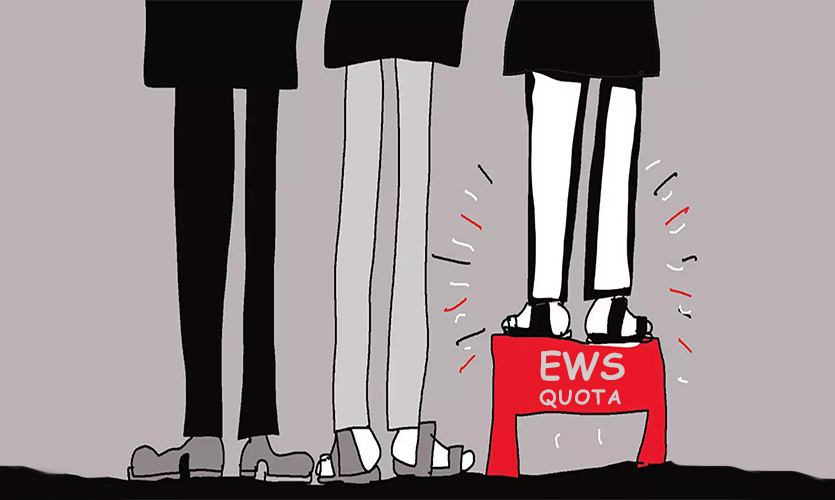The subject of reservation in India has a long history of being a valid source of contention and heated debates. The recent 10 percent quota allotted to the Economically Weaker Section (EWS) has fueled the arguments further.
This week, the Supreme Court upheld the validity of the 103rd amendment that carved out an “economically weaker section” that would not include SCs, STs and OBCs already having reservations.
The provision introduced ahead of the 2019 general election by the Prime Minister Narendra Modi-led BJP administration, took shape and has been imposed in several educational institutions.
The verdict was special not only because it was the final ruling administered by Justice UU Lalit as the Chief Justice of India, but also because it changed the purview of reservation in contrast to what has been historically limited to caste, tribes and communities.
Politicians, lawyers and activists, however, took no time in slamming the verdict and perceived it as a discriminatory action.
In the 3-2 divided verdict, Justices Dinesh Maheshwari, Bela M Trivedi and JB Pardiwala delivered the majority opinions, while former CJI Lalit and Justice S Ravindra Bhat held the minority view. In keeping with this, some compelling arguments from both sides can make one reconsider the idea of reservation.
Why Has The Debate Resurfaced?
The judgement upholding the validity of the EWS quota reiterated how it made perfect sense to grant it to the economically struggling people, who belonged to the forward classes; while excluding the backward classes mentioned in Articles 15(4), 15(5), and 16(4) from this layer because they had already received affirmative action in the form of reservations. According to the Supreme Court, adding them to the EWS group would only double their advantages.
The 103rd Amendment was intended as a means of poverty alleviation. Since general classes also include poor sections, improving their living conditions under the amendment cannot be recognised as infringement of the fundamental framework of the Constitution.
The Centre testified before the Supreme Court that the “totally independent” reservation for SCs, STs, and OBCs has not been affected by the 10 percent quota allocated to the economically weaker sections in admissions and jobs out of the 50 percent general category seats.
The law officer used the Multi-dimensional Poverty Index established by the Niti Ayog to state that the EWS made up 18.2 percent of the general category’s entire population.
Attorney General KK Venugopal argued that the reservation for OBCs, SCs, and STs falls under other categories other than the EWS quota, and does not run against the Constitution’s fundamental principles.
Questioning The Constitutional Framework
Justice Bhat and former Chief Justice Lalit dissented from the majority opinion on the constitutionality of the 103rd Amendment, claiming that it creates an “exclusion” that “strikes at the heart of the equality code… which is a part of the core of the Constitution”.
Justice Bhat said:
“The application of the doctrine (of) classification differentiating the poorest segments of the society, as one segment (i.e., the forward classes) not being beneficiaries of reservation, and the other, the poorest, who are subjected to additional disabilities due to caste stigmatisation or social barrier based discrimination – the latter being justifiably kept out of the new reservation benefit, is an exercise in deluding ourselves that those getting social and educational backwardness based reservations are somehow more fortunate.”
He highlighted that not only does the exclusion add insult to injury but also deprives the backward classes of equal opportunity. In addition to this, the purpose of reservation under Articles 15 and 16 is to address the underrepresentation of SCs and STs, as well as other socially and educationally disadvantaged sections. It is not a means of financial upliftment.
They cannot be excluded from the EWS quota under the provisions of Article 46, which promotes the economic and educational interests of SCs, STs, and other weaker groups, while also safeguarding them from social injustice.
In order to qualify for reservation of national commissions, other groups had to pass the SC, ST, and backwardness tests. But did the same apply to the EWS?
The arguments of the attorneys contesting the EWS quota on the grounds that they violated the 50 percent cap were rebutted by Justice Maheshwari, who noted:
“If at all the cap of 50 percent is the final and inviolable rule, the classes already standing in the enabled bracket of 50 percent cannot justifiably claim their share in the extra 10 percent, which is meant for a separate class and section, i.e., economically weaker section.”
The main cause of discrimination is still based on caste, although other standards of deprivation could include gender, economic status, geography, and so on. Expanding the economic pie remains the primary objective, despite the inclusion of poverty as a factor in discrimination, and the proposal of restitution being a positive step.
Achieving this three decades after Mandal, will require significant social, economic, and political lifting, but could potentially redefine affirmative action to be more inclusive.
Read more: SC Bans ‘Two-Finger’ Test On Sexual Assault Victims










